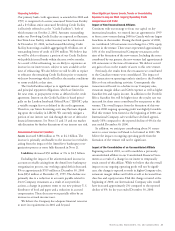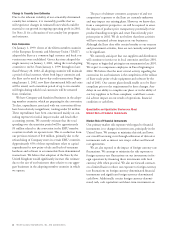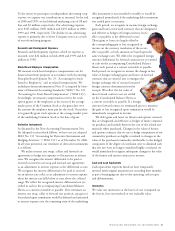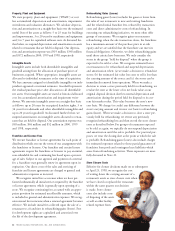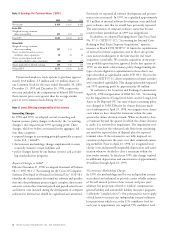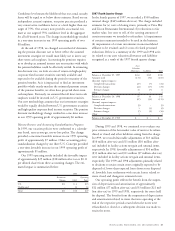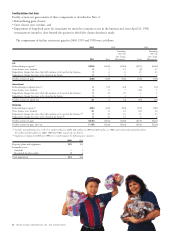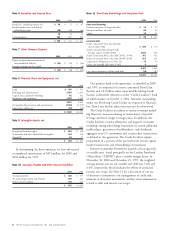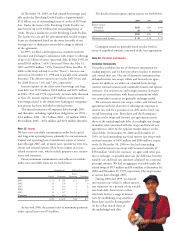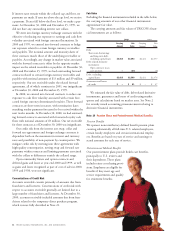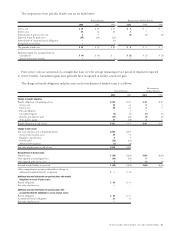Pizza Hut 2000 Annual Report Download - page 48
Download and view the complete annual report
Please find page 48 of the 2000 Pizza Hut annual report below. You can navigate through the pages in the report by either clicking on the pages listed below, or by using the keyword search tool below to find specific information within the annual report.
46 TRICON GLOBAL RESTAURANTS, INC. AND SUBSIDIARIES
Property, Plant and Equipment
We state property, plant and equipment (“PP&E”) at cost
less accumulated depreciation and amortization, impairment
writedowns and valuation allowances. We calculate deprecia-
tion and amortization on a straight-line basis over the estimated
useful lives of the assets as follows: 5 to 25 years for buildings
and improvements, 3 to 20 years for machinery and equipment
and 3 to 7 years for capitalized software costs. As discussed fur-
ther below, we suspend depreciation and amortization on assets
related to restaurants that are held for disposal. Our deprecia-
tion and amortization expense was $319 million, $345 million
and $372 million in 2000, 1999 and 1998, respectively.
Intangible Assets
Intangible assets include both identifiable intangibles and
goodwill arising from the allocation of purchase prices of
businesses acquired. Where appropriate, intangible assets are
allocated to individual restaurants at the time of acquisition.
We base amounts assigned to identifiable intangibles on inde-
pendent appraisals or internal estimates. Goodwill represents
the residual purchase price after allocation to all identifiable
net assets. Our intangible assets are stated at historical allocated
cost less accumulated amortization and impairment write-
downs. We amortize intangible assets on a straight-line basis
as follows: up to 20 years for reacquired franchise rights, 3 to
34 years for trademarks and other identifiable intangibles and
up to 20 years for goodwill. As discussed further below, we
suspend amortization on intangible assets allocated to restau-
rants that are held for disposal. Our amortization expense was
$38 million, $44 million and $52 million in 2000, 1999
and 1998, respectively.
Franchise and License Fees
We execute franchise or license agreements for each point of
distribution which sets out the terms of our arrangement with
the franchisee or licensee. Our franchise and certain license
agreements require the franchisee or licensee to pay an initial,
non-refundable fee and continuing fees based upon a percent-
age of sales. Subject to our approval and payment of a renewal
fee, a franchisee may generally renew its agreement upon its
expiration. Our direct costs of the sales and servicing of
franchise and license agreements are charged to general and
administrative expenses as incurred.
We recognize initial fees as revenue when we have per-
formed substantially all initial services required by the franchise
or license agreement, which is generally upon opening of a
store. We recognize continuing fees as earned with an appro-
priate provision for estimated uncollectible amounts, which
is included in general and administrative expenses. We recog-
nize renewal fees in income when a renewal agreement becomes
effective. We include initial fees collected upon the sale of a
restaurant to a franchisee in refranchising gains (losses). Fees
for development rights are capitalized and amortized over
the life of the development agreement.
Refranchising Gains (Losses)
Refranchising gains (losses) includes the gains or losses from
the sales of our restaurants to new and existing franchisees
and the related initial franchise fees, reduced by transaction
costs and direct administrative costs of refranchising. In
executing our refranchising initiatives, we most often offer
groups of restaurants. We recognize gains on restaurant
refranchisings when the sale transaction closes, the franchisee
has a minimum amount of the purchase price in at-risk
equity and we are satisfied that the franchisee can meet its
financial obligations. Otherwise, we defer refranchising gains
until those criteria have been met. We only consider the
stores in the group “held for disposal” when the group is
expected to be sold at a loss. We recognize estimated losses
on restaurants to be refranchised and suspend depreciation
and amortization when: (a) we make a decision to refranchise
stores; (b) the estimated fair value less costs to sell is less than
the carrying amount of the stores; and (c) the stores can be
immediately removed from operations. When we make a
decision to retain a store previously held for refranchising, we
revalue the store at the lower of its net book value at our
original disposal decision date less normal depreciation and
amortization during the period held for disposal or its cur-
rent fair market value. This value becomes the store’s new
cost basis. We charge (or credit) any difference between the
store’s carrying amount and its new cost basis to refranchising
gains (losses). When we make a decision to close a store pre-
viously held for refranchising, we reverse any previously
recognized refranchising loss and then record the store closure
costs as described below. For groups of restaurants expected
to be sold at a gain, we typically do not suspend depreciation
and amortization until the sale is probable. For practical pur-
poses, we treat the closing date as the point at which the sale
is probable. Refranchising gains (losses) also include charges
for estimated exposures related to those partial guarantees of
franchisee loan pools and contingent lease liabilities which
arose from refranchising activities. These exposures are more
fully discussed in Note 21.
Store Closure Costs
Effective for closure decisions made on or subsequent
to April 23, 1998, we recognize the cost
of writing down the carrying amount of a
restaurant’s assets as store closure costs when
we have closed or replaced the restaurant
within the same quarter our decision
is made. Store closure
costs also include costs
of disposing of the assets
as well as other facility-
related expenses from



